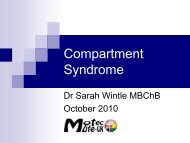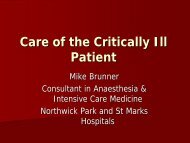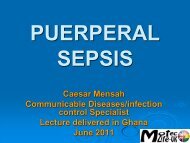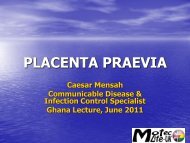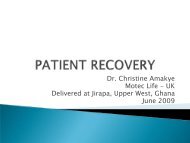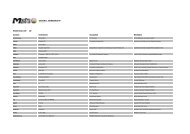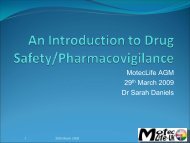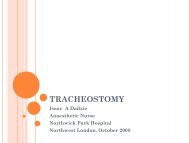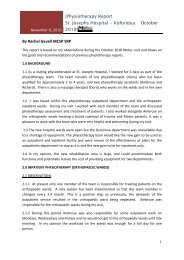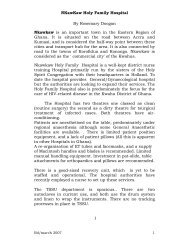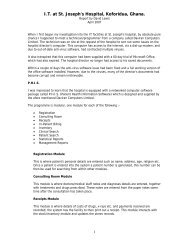Post-operative Nursing Management - MOTEC LIFE-UK
Post-operative Nursing Management - MOTEC LIFE-UK
Post-operative Nursing Management - MOTEC LIFE-UK
You also want an ePaper? Increase the reach of your titles
YUMPU automatically turns print PDFs into web optimized ePapers that Google loves.
RGN JOY LAUDEWATFORD GENERAL HOSPITAL, ENGLAND
Monitor patient on the ward to detect trendsin vital signs and to manage accordingly To recognise deteriorating trends and requestrelevant medical/out reach input Assess patients needs to provide individualand holistic care post<strong>operative</strong>ly Provide safe and relevant nursing care
When the patients care is transferred from therecovery staff to ward staff it is important tohave handover to be able to carry on furtherrecovery management:• Patients name and age• Relevant Past medical History• Allergies/intolerances
• Details of anaesthesia and surgery• Fluid/blood loss and replacement• Analgesia given during surgery• Completed drug chart for requiredpost-op analgesia, anti-emetics andIV fluids and other relevant drugs
• Details of drains and wounds• When can patient eat and drink• Baseline vital signs and observations• Specific post<strong>operative</strong> plan
Once the patient leaves the recovery room andadmitted to the ward nursing interventions forfurther 24hours include the following:‣ Monitor vital signs including Blood pressure,Respiration, Pulse rate , O2 saturation andTemperature‣ 15mins for first hour‣ 30 mins for next 2hours‣ Hourly for next 2‣ Then if stable 4 hourlyWhile monitoring these vital signs it is also important to observe(look, feel, listen)The results should be compared against the baseline pre<strong>operative</strong>and post anaesthetic vital signs readings.
‣ Assess resp rate, oxygen saturation andadminister supplemental oxygen as prescribed‣Assess the surgical site and wound drainagesystems‣Assess level of consciousness, orientation andability to move extremities‣Assess pain level, pain characteristics (locationand quality) and timing, type and route ofadministration of last pain medications‣Administer analgesics as prescribed and assesstheir effectiveness in relieving pain‣Position patient to enhance comfort and safety
‣Assess Intravenous sites for patency andinfusions for correct rate and solution‣Assess fluid input and urine output and fluidbalance chart‣Provide information to patient and family
Hypovoleamic Reduction in systolic bp can indicatehypovoleamic shock that leads to inadequatetissue perfusion , damage at a cellular level andultimately major organ failure Early signs of reduced tissue perfusion indetecting signs of shock• Restlessness or confusion• Increased respiratory rate• Tachycardia• Low urine output• Cold peripheries
Cardiogenic Death in many acutely ill patients as a result byfailure of myocardial pump. In response to surgery metabolic demands of thebody increases > adrenaline and nor-adrenalineare released > as the heart rate increases due tocompensatory mechanism the body’s tissues andcells then require more oxygen whichexacerbates the performance of the alreadypressurised myocardium. This results to cardiacarrhythmia or myocardial infarction.
Septic shock Life threatening low BP due to sepsis. Sepsis – a serious body wide response tobacteraemia or any other infection.
Monitor patients closely• Vital signs• Fluid input and output• Adequate pharmacological interventions• Observe and record trends of improvement anddeterioration Administer supplementary oxygen Fluid replacement/ blood transfusion ofneeded Seek medical specialist assistance
Give supplemental oxygen therapyMaintain oxygen saturation levels above 95% to preventhypoxia Monitor oxygen saturation This is important because it can cause respiratory failure Breathing• Respiration rate, depth and regularity• Look, feel and listen Effect of pain on breathing
Assisting the replacement of fluids andelectrolytes lost during surgery. Contributing factors for fluid imbalance postop• Bowel preparations• Infiltrated cannula• Poor fluid prescription• Pre-<strong>operative</strong> fasting times
Aim : ensuring adequate hydration equals tosafe nursing practice Crystalloid• 0.9% Na saline• 5%dextrose• Hartmann's Solution Colloids• Volplex Blood/blood components
Wound – colour, infection, bleeding, stitches Drains – rate and volume of blood loss Urinary catheter – position, patency, hourlyurine output/volume, colour andconcentration
TIME INPUT OUTPUTORAL IV OTHER TOTAL URINE VOMIT OTHER DRAINS TOTAL00000100020003000400050006000700Total Input +/- Balance Total Output
“ Pain is whatever the patient says it is, and existswhenever the patient says it does.”(McCaffrey 1968) Under treated pain causes harm No two people experience pain in the same way. Pain control is very important to the well beingand recovery of a patient. 2 Classifications of Pain (Acute and Chronic) Pain assessment Key pain assessment factors Pain assessment tools
Types of <strong>Post</strong> <strong>operative</strong> pain relief used• IV, IM, PO opioids, PCAs• PO, PR non-steroidal anti inflammatory drugs• Epidurals• Local anaesthetic blocks
<strong>Post</strong> <strong>operative</strong> Nausea and Vomiting• Very important for patient recovery, it can causepatients further distress, exhaustion, loss of fluid andelectrolytes Medications via PO, IM, IV• Metoclopramide, domperidone, cyclizine,ondansetron, Naso-gastric tube and drainage as required• Excessive vomitting can be relieved with NG tube Replacement IV fluids• Replace loss of fluid and electrolytes
AVPU GCS Agitation, confusion, disorientation Movement of limbs and neurological changes
Prevention of Thrombus formation ie. DVT,PE Prophylactic treatment are used such asClexane or continuous heparin infusions Leg exercises in bed Relieving pressure to at risk areas byrepositioning patients and use of pressurerelieving equipments
What is a care plan? A nursing care plan outlines the nursing careto be provided to a patient. It is a set ofactions the nurse will implement to resolvenursing problems identified by assessment.The creation of the plan is an intermediatestage of the nursing process. It guides in theongoing provision of nursing care and assistsin the evaluation of that care.
Based on 12 Activities of Daily Living• Maintaining safe environment• Communication• Breathing• Eating and Drinking• Elimination• Washing and Dressing• Controlling Temperature• Mobilisation• Working and Playing• Expressing Sexuality• Sleeping• Death and Dying
Assessment/usual routinePatientsproblemGoal<strong>Nursing</strong>ActionEvaluationMobilisationLouisemobilisation anddistance shecould walkwithout painprior to surgerywas approx 300yards<strong>Post</strong><strong>operative</strong>ly, she has lackof confidencemobilising buther pain wasunder controlLouise toregain herconfidencemobilising‣Giveexplanationandreassuranceprior to andwhenmobilising‣Observesigns ofdislocationLouise cansafely mobiliseand transferfrom bed tochair and bedto toilet withconfidence



